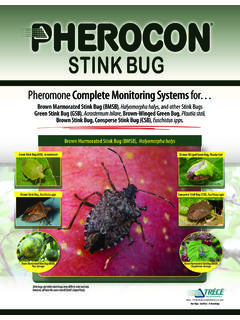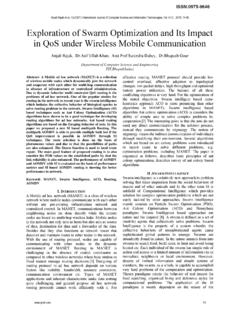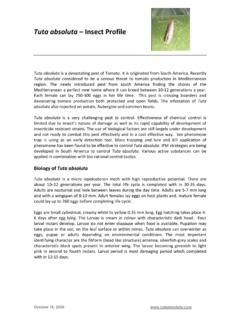Transcription of Behavior: Spraying - Mobile SPCA
1 Behavior: SprayingCats sometimes engage in a behavior called urine Spraying orurine marking. The cat stands, backs up to an object, holds histail up erect and quivering, and releases urine out backwardsonto the object. The urine sprayed differs chemically from theurine cats normally release from a squatting position because italso contains oily secretions from the anal glands. Sprayed urineis extremely pungent. Some people describe it as smelling likeammonia; others say it has a heavy musky odor. Cats occasion-ally spray from a squatting do cats spray urine? They spray during territorial disputes,during aggressive conflicts, and during sexual encounters. Themajority of cats who spray just do their Spraying outside.
2 Theyadvertise their presence in a territory by Spraying visually con-spicuous sites. Cats time share territories, so the marks enablethe cats to space themselves out so that they don t often cats spray urine inside their homes. Often indoor sprayingresults from conflicts between cats in the home or from the res-ident cat feeling threatened by outside often, cats who spray are reproductively intact males(toms) but females do sometimes spray. Neutering is the mosteffective way to curb Spraying in a tomcat. In one study, 77 per-cent of cats stopped or significantly reduced Spraying within sixmonths of being neutered. Neutered cats can spray as well.
3 Tenpercent of male cats neutered before 10 months of age will stillspray as adults. In households with numerous cats, at least onecat will likely spray, even if all the cats are to do: Neuter or spay the Spraying cat. Identify the reasons why your cat may be Spraying . Forinstance, if your cat is reacting to the sight of cats outside,block your cat s view. If your cat is reacting to the scent ofcats outside, possibly through a screen door or from odors onyour shoes, prevent your cat from coming into contact withthese scents. Keep the door closed and remove shoes out-side, before entering the home. Discourage cats from hanging around outside your devices, such as the Critter Gitter , theScarecrow , or the Scraminal , all function to frighten out-door cats away.
4 The Scat Mat and the Sofa Saver can beused to keep outdoor cats away from doors and windows. If your cat is Spraying in one or a few locations, you can makethese areas less appealing, using some type of booby trap,such as Ssscat . Ssscat is a motion-activated device thatsprays the cat with a harmless but unpleasant , you can put out an unwelcome mat for the cat by placing foil, plastic wrap, orupside-down vinyl carpet runner where yourcat sprays. Be aware that cats often justchoose a new spot to spray. You can also try eliciting a different behav-ior in the sprayed locations. Place itemsthat stimulate behaviors incompatible withspraying, such as the food dish or toys, inthe spots.
5 You can try placing a litter box in each location. If the cat isspraying on the wall beside the litter box, try attaching a lineron the wall and drape it down into the box. Should the catspray there, the urine at least will drip down into the box. Spray Feliway in the areas where your cat is is a synthetic pheromone designed to elicit calm,friendly behavior in cats. Research supports the claim thatFeliway reduces indoor urine Spraying . If the Spraying is due to conflict among resident cats, youshould seek counsel on resolving the conflict. You may needto separate the cats or at least isolate the Spraying cat untilyou are able to restore harmony. If this is not possible, re-hom-ing to reduce your numbers may be the only viable solution.
6 Aspraying cat might not spray at all in a new home with fewercats. Drug therapy can help resolve a Spraying problem. There arenumerous medications that have been demonstrated to beeffective in individual cases , the Benzodiazepines ( ), other anti-anxiety drugs ( Clomipramine orBuSpar), or progestins. Make sure you clean sprayed areas with an enzymaticcleanser designed to eliminate odors. If you can do so safely, allowing the cat to spend time outsidesometimes results in the cat Spraying outside the home ratherthan inside. Building a large wire enclosure for the cat outsidemay be sufficient to stimulate him to spray outdoors. What not to do: Do not punish the cat by hitting, spanking, or slapping forspraying.
7 Similarly, do not take the cat to the area and admon-ish him. This might well teach the cat to be afraid of you. Thecat may actually spray more if he is stressed by the punish-ment. Resolving Feline SprayingTiberius spies a new neighborhood cat investigating his back-yard an intruder on his turf! He backs up to a chair near the patiodoor, raises his tail and, with a quiver, lets fly with several quicksquirts of foul-smelling urine. When finished, Ti resumes his busi-ness of patrolling for nonexistent rodents between long naps inthe the Message?Urine stains found approximately at cat-nose level on vertical sur-faces, such as furniture, drapes or walls, are telltale signs offeline Spraying .
8 Urine marking is a method of olfactory signalingthat may lay claim to territory, assert status (both high and low), offer sexual availability or indicate stress or frustration. Sprayingappears to be a form of communication that's aimed at othercats or, in the case of frustration, more likely aimed at most urine marking is ccomplished via Spraying ,some cats may mark by squatting on horizontal surfaces. Themarked site will offer a clue as to where the trouble lies. Sprayingnear doors or windows can be attributed to the stress of anindoor cat, like Ti, who spots an outside interloper on his or herterritory. A marked suitcase can indicate stress over an impend-ing vacation, signifying the owner's absence, an "invading" petsitter, a change in routine, or worse: a stay at the boarding normal feline response, Spraying is a difficult problem toeliminate.
9 Also, backsliding in times of stress is not unusual. Mostspraying is done by unneutered males, and by unspayed femalesin heat. Sterilization will yield a cessation of Spraying within twoweeks of surgery for all but roughly 10 percent of males and 5percent of females. These numbers can be halved with propertreatment. If your cat has sprayed, tackle the problem immediately. Byignoring the behavior, even for a few weeks, it becomes soingrained that environmental and behavioral modification will notresolve the problem, and pharmacological intervention will benecessary. If your neutered cat has sprayed, first attempt to determinethe cause. Then, either remove it from his environment or cut offaccess to it.
10 If the problem is household overcrowding, anotherhome may be needed for your newest foster kitty. In Ti's case, amesh fence-topper could be used to prevent other cats fromclimbing into the yard. Or, a motion detector could be installedto set off a garden hose or flashing lights to send feline invaderspacking. Ti's guardians could install shades, shutters or othervisual barriers to prevent him from witnessing others on his areas must be carefully cleaned with a commercialodor neutralizer. Any lingering scent may encourage a cat to re-mark the spot to make his olfactory message clear. A strong win-tergreen or citrusscented room deodorizer may keep the cataway from the spot; however, it may also prompt him to sprayelsewhere.







